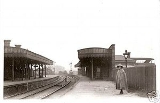
Selsdon railway station
Encyclopedia

Oxted Line
The Oxted Line is a railway line in southern England. It was originally operated jointly by the London, Brighton and South Coast Railway and the South Eastern Railway. It is now part of the Southern franchise....
and the now-closed Woodside and South Croydon Railway
Woodside and South Croydon Railway
The Woodside and South Croydon Joint Railway was a short, relatively short-lived and unsuccessful railway in the London Borough of Croydon in London, England. Its site is now largely occupied by Tramlink.- Route :- History :...
. Opened in 1885 as "Selsdon Road", it was two miles from Selsdon
Selsdon
Selsdon is an area located in the southern suburbs of the London Borough of Croydon. The suburb was developed during the inter-war period during the 1920s and 1930s, and is remarkable for its many Art Deco houses...
village. The name was changed with effect from 30 September 1935 in an attempt to attract more passengers to the line - users of the railway preferring to use nearby South Croydon
South Croydon railway station
South Croydon railway station is in the London Borough of Croydon in south London, in Travelcard Zone 5. It is on the Brighton Line at its junction with the Oxted Line. The station and all trains serving it are operated by Southern.-History:...
, which had a higher frequency of service.
Selsdon was at the junction of the two lines and was jointly operated by the SER
South Eastern Railway (UK)
The South Eastern Railway was a railway company in south-eastern England from 1836 until 1922. The company was formed to construct a route from London to Dover. Branch lines were later opened to Tunbridge Wells, Hastings, Canterbury and other places in Kent...
and LBSCR prior to the 1923 railway grouping
Railways Act 1921
The Railways Act 1921, also known as the Grouping Act, was an enactment by the British government of David Lloyd George intended to stem the losses being made by many of the country's 120 railway companies, move the railways away from internal competition, and to retain some of the benefits which...
. The station's four platforms (two for the Woodside line, two for the Oxted line) were respectively decked out in SER and LBSCR signage and fittings. A subway provided access to the Woodside line platforms from the main station building. The station closed as a wartime economy measure on 1 January 1917 and the Oxted platforms reopened on 1 March 1919,closing permanently on 14 June 1959. In the year of the closure these platforms were used by only three trains a day.
The line between Woodside and Selsdon closed for regular services on 1 January 1917 but was retained for occasional special services. It reopened with a regular passenger services upon electrification of the line through to Sanderstead on 30 September 1935.
Traffic was controlled by two signalboxes: "Selsdon North", which controlled traffic to and from the Woodside line, with the up line used for reversing some trains; and "Selsdon South" ("Selsdon" after 1935) for the Oxted line. The North box closed on 22 September 1935 following a signalling reorganisation. The South box, with 22 levers, remained in use until 1 April 1984. From 1934 and for many years thereafter, a trailing southbound crossover and a private siding
Rail siding
A siding, in rail terminology, is a low-speed track section distinct from a running line or through route such as a main line or branch line or spur. It may connect to through track or to other sidings at either end...
connected to the up line served a roofing company situated to the south of the junction, which received its raw materials by rail.
A goods yard with cattle pens and a chalk pit opened shortly after Selsdon's opening and in 1894 the Anglo-American Oil Company installed oil tanks there. It closed to general freight on 17 October 1968, but the oil tanks remained in use until 1993 - a spur extending as far as Fairfield Path Bridge just north of the site of Spencer Road Halt led to them.
Selsdon saw its last passenger train on 13 May 1983, with the Woodside and South Croydon line officially closing three days later. At closure Selsdon was the last gas-lit station in London. The station buildings were demolished in the 1960s , leaving a short section of canopy over the subways and a small wooden hut was erected from where when tickets were issued although latterly this was seldom manned. As at 2009 the Oxted line platforms remain intact plus the former down Woodside line platform. The heavily overgrown track leading to the former goods yard and oil storage facility can be seen from Dornton Road footbridge. The site of the Up Woodside line platform and main station buildings are now occupied by housing development.

